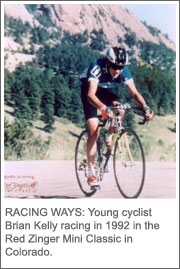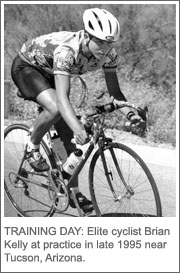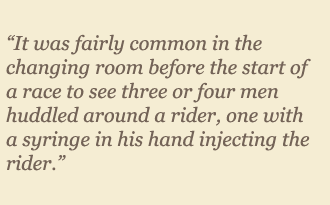Brian Kelly is a former elite cyclist who recently received his Ph.D. in biochemistry from the University of Utah. Here, he recounts his climb into the sport, only to face mounting pressures to dope.
ONE CYCLIST’S EXPERIENCE

By Brian Kelly
Now 31 years old and with ten years of perspective, I can more clearly see the strength that it took to leave my dream career, my first love, behind. I was only 9 years old when the spirit of cycling captured me. Twelve years later, I learned that there is a ceiling that most young riders eventually hit and a time when they must choose whether to use performance-enhancing drugs in order to remain competitive. This is my story.
During the summer of 1985, a family camping trip near Ward, Colorado led to my initial exposure to bicycle racing. I caught sight of some racing cyclists passing in front of the mountains, and I was dazzled by their speed and their zeal. It was the Coors Classic, en route to Estes Park. I already had a general interest in endurance athletic pursuits and a few foot races under my belt, but it was that first glimpse of those cyclists that I would describe as the beginning of my interest in bicycle racing.
One year passed, and I saw an article in the local newspaper for an upcoming bicycle race for kids between the ages of 10 and 16 called the Red Zinger Mini Classic. I asked my father to get me a racing bicycle, since all I had at this point was a dirt bike. He came home with a red 10-speed that he likely purchased at K-mart. Now with a bicycle, I was ready to enter the race, which I did.
I was the youngest and smallest kid racing. The first stage was a time trial. After the finish, I threw up as I had ridden so hard not to get caught. Subsequent stages passed through the Colorado Front Range area. In some I finished dead last! Near the end of the week, there was a race up NCAR, a short, very steep hill on the southwest side of Boulder, Colorado. I placed 10th in my age group on that stage. The following day my name was listed in the local paper, and that was the first time I was so recognized for a sporting achievement for all to see.

During the ensuing few years, I continued racing in the Red Zinger Mini Classic, with occasional races in Vail and Aspen, Colorado. With each race, I grew more attached to the sport.
In 1991, now age 15, I saved money from my paper route in order to pay my way to Germany where I could race with a sports exchange program, Sports For Understanding. There I stayed with a host family for two weeks and raced in a couple of road races and a track race. I loved it, riding at speed through these old German towns, on cobblestones, through narrow passageways. It was infectious!
The following two weeks I spent in Stuttgart, Germany, where I trained and watched the 1991 World Cycling Championships, both on the track and the road. Somehow I managed to get into the U.S. team tent lining the start/finish straight on the road course from where I watched the men’s professional road championships. Disappointed when a childhood hero of mine, Greg LeMond, dropped out, I was nonetheless thrilled to be so near him. It was this trip that cemented my dream to become a professional bicycle racer.
Over the next year, my training became more focused on the goal of winning a race, something that had eluded me in the previous six years of racing. I trained on all the courses for that summer’s Red Zinger Mini Classic. The training, dedication, and determination paid off. I won the overall race and a number of stages that year. My name was now published in VeloNews, alongside my heroes, some of whom had also won the Red Zinger Mini Classic before going on to become professionals. I dared to imagine that I might also have that fitness, skill, and drive required to achieve my goal of racing in Europe.

In 1993, I spent some time at the Olympic training center in Colorado Springs and was a member of the USCF junior regional team. In 1994, I had caught the eye of the national team coaching staff, and I was selected to compete for a spot on the junior world’s team that year. It was a great experience competing with other junior riders to represent the United States in Quito, Ecuador. I did not earn a spot on the world’s team; however, I was chosen to ride in the Olympic Festival that year, where I competed in the road race and time trial. In between these national level events, I competed throughout the western United States, and gained the license of Category 2 while I was still a junior.
In 1995, as a first-year senior rider, I raced for Taya Chain, a top amateur team in the nation. I competed in many domestic events, and often helped the team win races. It was a big change to go from racing fairly short junior events to multi-day stage races with riders twice my weight. Intimidating would be one word to describe it! My thirst for racing in Europe continued to develop, and I knew I needed to find a way to race there if I was ever going to be a professional.
In the spring of 1996, I purchased a plane ticket to Brussels, Belgium, where I was to rent a room in the city of Gent from an individual who housed many cyclists. Gent is located in Flanders and is nearby many fabled cobblestone climbs that you often read about in cycling magazines. Perhaps the weather upon arrival in Gent was foreshadowing what was to happen to my dream of becoming a professional cyclist. I arrived May 1, 1996, to cloudy, cool, drizzly conditions. This would be the typical weather for the remainder of my time there.
I was taken to a house that I would share with riders from Australia and New Zealand, all of whom were in Belgium trying to make names for themselves. We had a nice little community in the house and there was always somebody to go training with if you were not racing that day. My room was on the third floor of the long and narrow house, and as I approached my room I could not help but notice that the ceiling had a large hole in it when what little sunlight that penetrated the clouds would enter.
I remember being somewhat surprised by the request from the landlord that if the police ever came to the house, to be certain not to answer the door. I am not sure if that was because the house probably wasn’t truly fit for occupancy, or perhaps he had other reasons.
My landlord ran a small Belgian cycling team, and a number of the riders staying in Gent would race for his team at various times during the season. I went to Belgium as somewhat of a free agent and I didn’t have a contract. So I would race in kermesses, Flemish for “Carnival,” that would include a bicycle race to accompany a village fête, during the week. Occasionally I would be asked to ride a larger race with a team if my performance in a kermesse was good. I typically would race three to four times per week, filling the remainder of my time there with training rides and occasional bakery stops.

I became accustomed to the style of racing in Belgium fairly quickly. However, there was one troubling aspect to which I had not previously been exposed. It was fairly common in the changing room before the start of a race to see three or four men huddled around a rider, one with a syringe in his hand injecting the rider. The first time I saw this, I was very disappointed, but I knew that I would race clean. Unfortunately, this use of such banned and potentially dangerous performance-enhancing substances as erythropoietin (EPO) and “pot belge” (a mix of heroin, cocaine, amphetamines and possibly other drugs) continued fairly regularly. It always left me with a deeply unsettling feeling and never became any easier for me to see or understand.
Indeed, here I was, a 19 year old, nearer than ever my dream of becoming a professional cyclist and racing in the Tour de France. Yet staring me in the face was the one thing that would eventually keep me from completely realizing it.
After a few weeks of racing in Belgium, one of the riders staying in another house owned by the same landlord told me he had been injected with some “vitamins.” His injection went bad somehow; the rider got very sick and had to go back to England to be treated. That was the last I ever saw or heard of that rider.
A short time later, an American cyclist who had been racing in Italy for a large team, approached me. He explained that with my results at this point, I could obtain a professional contract, but first I would have to subscribe to a “medical program.” He told me that he could help me obtain “recovery agents” and my performances would improve drastically. He wasn’t the only person telling me this; I had directors of teams saying that they liked my abilities and that they could help foster my development, but that I would have to use their “medical program.” I had always told myself that I would race clean, so I always declined these offers.
Some days later, when I was warming up for another kermesse, I was hit by a car. I had no broken bones, but I sustained a large amount of soft tissue damage, particularly in my lower leg. Initially, I was told that I would be back racing in a couple weeks, so I stuck around Gent for treatment. However, once it was clear that my injuries were not healing quite so quickly, I decided that I should head back to Boulder, Colorado, to fully recover.

At this point, I was fairly disillusioned with the prospect of becoming a professional cyclist given all that I had seen and been told in Europe regarding the prevalence of performance-enhancing drug use. I had not given up hope that I could be strong enough to compete without the drugs and still gain a contract to race professionally. In light of this plan, I decided to enroll part-time at the University of Colorado, which had invited me to compete on its collegiate cycling team. At the time, this team was the perennial favorite to win the national championships. I took classes and trained to get back to racing, but the injuries sustained in Belgium led to other injuries, and it became apparent that I needed a large amount of time off the bike to heal. My love for learning combined with my experiences in Europe led me to forfeit my boyhood dream and leave competitive cycling altogether.
After my initial year of taking classes part-time, I enrolled in a course of education that would take me to dual degrees in molecular biology and biochemistry. I was enthralled with research and decided to pursue a Ph.D. in biochemistry, which I recently completed. Now at a crossroads in my career path, and with my longstanding love for competitive sports, I have embarked on a road that I hope will lead me to the point of improving detection techniques of performance- enhancing substances and cellular modifications that may be occurring in athletics.
I hope that, someday, young, aspiring riders will not be faced with a choice of using performance-enhancing drugs in order to compete on equal ground. Perhaps my personal experience, professional education, and dedication will allow me to play a part in achieving this important goal.

